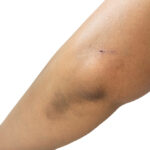Looking to maintain a healthy rich complexion? Then you must understand the four factors of skincare which are; knowledge, self-examination, protection, and skin nurturing.
Knowledge;
This is the first factor of maintaining great skin. You need to know enough about the skin to figure out how to take care of the skin. Unlike other skin tones, melanin is what makes the skin of color stand out. But it’s not the only distinguishing feature of brown skin. Other features that make brown skin stand out include;
- Futcher’s Lines; are lines that appear on the upper arm, separating the darker skin tone on the outside, from the lighter skin on the inner part of the arm.
- Hypopigmentation of the mid-line; is characterized by a lighter skin tone on the mid-chest region, compared to the slightly darker skin tone on the sides of the chest.
- Hyperpigmentation of palm lines; the lines in the palm are noticeably darker than the skin on the rest of the palm.
- Kerototic Palmer Pitting Hyperpigmentation; tiny dips or holes in the palms are noticeably darker, just like the palm lines.
- Pigmented Nail Streaks; from the edge of the nails to the cuticle, are dark brown streaks. In cases where only one nail has the dark brown streak, tests must be carried out by a dermatologist to determine if cancer is present.
- Gingival Hyperpigmentation; noticeably darker gums around the teeth.
Self-examination;
This is a crucial step after knowledge, to ensure a healthy rich complexion. Generally speaking, brown skin is less likely to suffer skin cancer, but that often comes at a risk. When brown skin surfers skin cancer, it tends to be deadlier compared to other skin tones. Brown skinned women (and men) must understand their risk of skin cancer, and ensure that any trace of cancer is detected early.
Self-examination should be done once each month, and detailed focus should be on the fingers, hands, toes, feet, mouth and nails. These areas are prone to melanoma skin cancer, and allow for easy detection. As a woman (or man) of color, watch out for black or dark brown spots in these places – whether big or small. Also watch out for new spots or changes in existing spots. Changes such as increase in shape, size, color or bump within the spot, are to be noted. A sore bump on the foot or toe is also a sign of skin cancer. Be mindful about the dark streaks on the finger or toenails – if you only find one streak, then it might be cancer. In summary, any unusual thing on your skin, any change at all should be reported to your dermatologist without delay.
According to the National Cancer Institute, you should follow these steps of self-examination for cancer symptoms;
- After bathing, use a handheld or full-sized mirror to scan all areas of your body. Check especially the warning areas such as your hands, fingers, toes, feet, nails, buttocks, genital region.
- After the initial scan, check the front and back sides of your body with the mirror. Raise your arms and legs to examine the inner areas.
- Look carefully at your palms, forearms, upper arms, elbows and undersides. Check in between your buttocks and genital region.
- Examine your feet and spaces between your toes closely.
- Examine your face and neck. You could also use a comb to shift your hair in bits, so as to examine your scalp.
Protection;
Moving on from knowledge and self-examination, you have to engage the third factor which is skin protection. Your skin should remain healthy so long as you protect it from the sun. Generally speaking, a rich complexion individual has a sun resistance figure of 13. This means that a brown woman can stay 13 times longer in the sun than a woman with white skin. But this doesn’t change the fact that sunscreen is essential for maintaining skin of color health.
Technically, sunscreens absorb harmful ultraviolet A (UVA) and B (UVB) rays before they can alter the skin. In the same vein, sun blocks shield the skin by creating protective barriers that reflect ultraviolet rays away from the skin. Depending on the SPF rating of the sunscreen, a rich complexion woman using an SPF 15 sunscreen could stay in the sun for 15 times longer (without risking a sunburn) than the average white woman. However, where there are underlying medical conditions e.g lupus, or irregular dark marks and special medications, an SPF 30 sunscreen would be required to ensure skin safety. Be on the lookout for wide range products with skin protective and UV rays resistant ingredients.
Tips for Using Sunscreen
- It is advised that all women and men with skin of color use sunscreen on a daily basis.
- Apply sunscreen 20 minutes before exposure to the sun. This is to ensure that the sunscreen has been absorbed by your skin, thus creating a protective layer against the sun rays.
- Apply sunscreen generously to all exposed skin. At least expend an ounce of sunscreen per use on your face, neck, hands and legs.
- Store your sunscreen in a cool and dry place, away from direct sunlight or heat.
- After swimming, bathing or engaging in a sweaty exercise, reapply your sunscreen. Ignore the “water resistant” label.
- Do not use an expired sunscreen, it could damage your skin. Hence, watch out for expiry dates.
- Apply sunscreen separately from foundation and makeup. This is to ensure that your face has enough sunscreen applied.
- Only purchase a product that meets your personal needs. Specific products would be a lot more effective than generic products.
Nurturing;
Nurturing is the fourth and final aspect of caring for your skin. You know how your skin reacts to certain things, hence avoid skin irritants. Here are a few potential irritants you should be mindful of;
- Skin cleansers, toners or astringents with ingredients like alcohol, propylene glycol, fragrance, or dyes.
- Skin products with essential oils as an ingredient.
- Skin moisturizers with lanolin, fragrance, dye, alcohol or propylene glycol as ingredients.
- Sunscreens with essential oil, and fragrance as ingredients.
- Makeups with essential oil
- High concentrated alpha-hydroxy acid.
- Fabric softeners and detergents with fragrance, preservatives or dyes in its list of ingredients
Once you avoid the ingredients and items listed above, pay attention on cleansing your skin regularly and properly. Don’t make the mistake of cleaning roughly and too much, or cleaning too little. So, avoid using harsh or irritable products on your skin. Check out these cleansing tips for your skin;
Skin Cleansing Tips
- Clean dirt, oil and makeup off your face daily.
- Stop using harsh cleansers or products that can irritate your skin.
- Use your fingertips in cleaning your face – run gently in circles.
- Only make use of products unique to your type of skin.
- Gently apply exfoliating skin care creams only when you need to clear off dead cells on your skin. Contact a dermatologist concerning the right product for you.
Conclusion
To care for your skin, you must first know about your skin and its uniqueness. Afterwards, ensure that you examine yourself daily, protect yourself from the sun with the appropriate sunscreen, and ultimately avoid using irritable products on your brown skin



